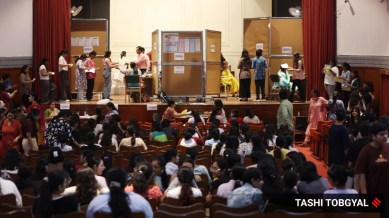Stay updated with the latest - Click here to follow us on Instagram
In DUSU polls, here’s how the fight between NSUI and AVBP has stacked up
The two national student wings, NSUI and ABVP, have traded dominance but rarely shared power evenly in the DUSU polls over the years.

Students across colleges in Delhi University lined up at polling stations Thursday to cast their votes in the Delhi University Students’ Union (DUSU) elections, often called a rehearsal for “big politics”.
Electronic voting machines have been placed in colleges across the city, and counting will take place on Friday, with results expected by the evening. While the first phase of voting ended at 1 pm, the second phase will begin at 3 pm and last until 7.30 pm. This year, 21 candidates are in the fray for the four posts of the central DUSU panel.
monthly limit of free stories.
with an Express account.
DUSU numbers
The most revealing trend over the past decade is not just who wins the DUSU polls, but how many students turn out to vote. The turnout has hovered in a narrow band, usually between 35 and 45 per cent, with a few exceptions.
In 2016, only 36.9 per cent of eligible students voted, the lowest in recent memory, and the Akhil Bharatiya Vidyarthi Parishad won. The following year, participation rose to around 42.5 per cent, with the National Students’ Union of India (NSUI) pulling off a rare win — bagging both the president and the vice-president posts, and the ABVP held the other two posts.
The highest turnout in over a decade came in 2018, at 44.46 per cent, buoyed by strong participation from evening colleges. The ABVP dominated that year, winning three of the four central panel positions, including that of the president. In 2019, turnout dipped to 39.9 per cent, and ABVP retained the presidency.
The pandemic years halted elections altogether, with no DUSU polls held from 2020 through 2022. When balloting resumed in 2023, turnout steadied at 42 per cent. The ABVP once again captured three of four top posts.
After the pandemic
In 2024, turnout crashed to just 29.7 per cent — the lowest in 13 years. That dip coincided with a surprise result: the NSUI made a comeback, with Ronak Khatri winning the DUSU president’s post. The dip also had to do with low interest from students after the Delhi High Court intervened, and rapped the varsity for defacement across the city during the campaigning.
Also Read | In DUSU polls, BJP, Cong take gloves off, line up key faces, national planks
It was the NSUI’s first presidential victory since 2017, breaking the ABVP’s long hold at the top. The ABVP, however, managed to secure the vice-president and secretary positions, while the NSUI candidate became the joint secretary.
Across these cycles, the two national student wings have traded dominance but rarely shared power evenly. The ABVP has generally been the stronger force, but the NSUI’s 2017 and 2024 wins show that when turnout fluctuates or discontent brews, the tide can shift.
Thursday’s polling will test whether student participation rebounds toward the 40-plus per cent levels seen before, or whether last year’s historic low signals a deeper decline in campus engagement.